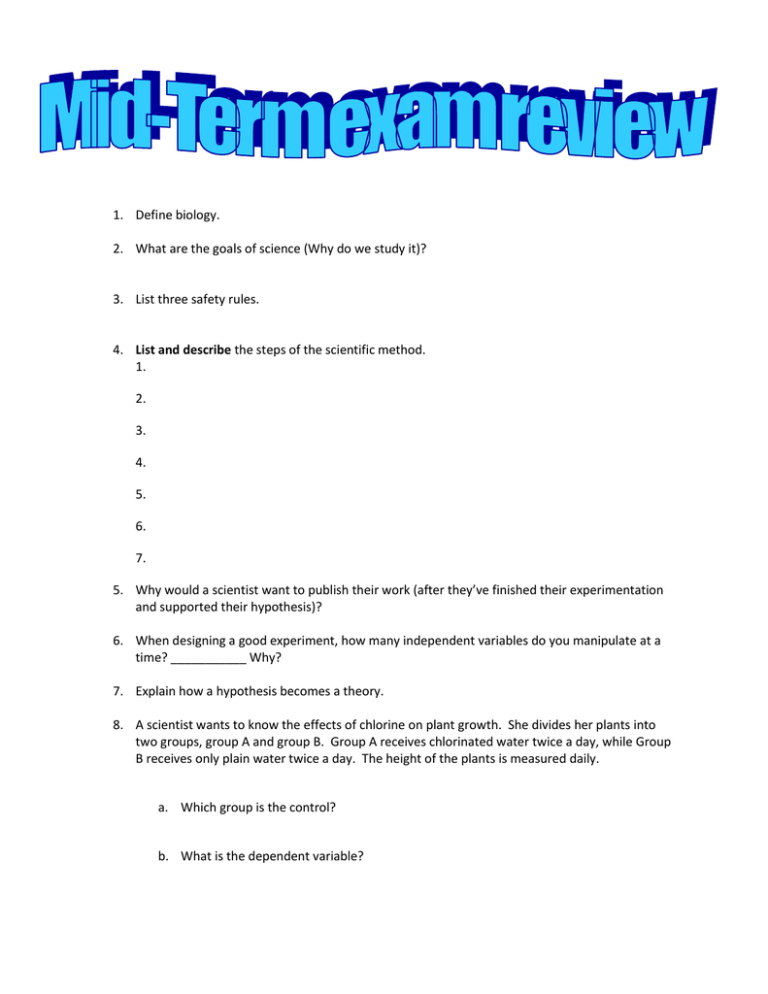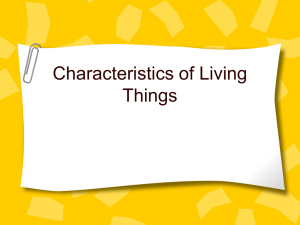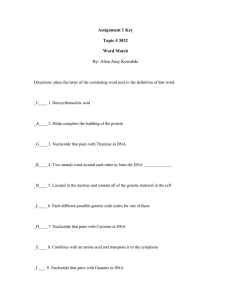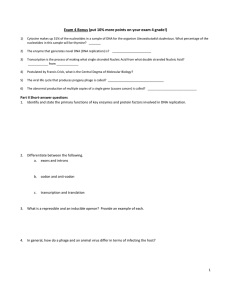1. Define biology. 3. List three safety rules.
advertisement

1. Define biology. 2. What are the goals of science (Why do we study it)? 3. List three safety rules. 4. List and describe the steps of the scientific method. 1. 2. 3. 4. 5. 6. 7. 5. Why would a scientist want to publish their work (after they’ve finished their experimentation and supported their hypothesis)? 6. When designing a good experiment, how many independent variables do you manipulate at a time? ___________ Why? 7. Explain how a hypothesis becomes a theory. 8. A scientist wants to know the effects of chlorine on plant growth. She divides her plants into two groups, group A and group B. Group A receives chlorinated water twice a day, while Group B receives only plain water twice a day. The height of the plants is measured daily. a. Which group is the control? b. What is the dependent variable? c. What is the independent variable? d. What is the purpose of group B? e. What would be three constants in the experiment? 9. Write the basic metric (SI) unit for: a. length: _________________ b. mass: __________________ c. volume: _________________ d. temperature: _____________ 10. Convert 9 cm to km. 11. List the 7 characteristics of life. 12. What is homeostasis? a. Give one example. 13. Identify the 6 kingdoms. Kingdom Cell Structures Cell walls with cellulose; some have chloroplasts Cell walls of chitin Cell walls of cellulose; have chloroplasts No cell walls or chloroplasts Cell walls without peptidoglycan Cell walls with peptidoglycan 14. List and define three types of bonds. 15. What is a monomer? 16. List all 5 functions of proteins. 17. What is activation energy? # of cells Most unicellular; some colonial or multicellular Mode of Nutrition Autotroph or heterotroph Most multicellular; some unicellular Multicellular Heterotroph Multicellular Autotroph or heterotroph Autotroph or heterotroph Autotroph or heterotroph Unicellular Unicellular Autotroph 18. In the following equation: C6H12O6 + 6O2 6CO2 + 6H2O identify the products and the reactants. a. Products= b. Reactants= c. In a chemical reaction, the atoms are ____________________, not created or destroyed. d. In a chemical reaction, energy can be released as what three things? 19. What two functions (jobs) do catalysts and enzymes serve? 20. What 3 conditions can affect the rate at which enzymes work? Using the diagram to the right, answer questions 21-24. 21. What temperature range do both the X and Y enzyme function at? 22. Which enzyme works over a broader temperature range? 23. Which enzyme works best at higher temperatures? 24. Fill out the chart with details about the four carbon (organic) compounds. Carbon Monomer (basic Function/Job Compound unit) Three Examples 25. Fill in the chart on the properties of water. Property of Definition Example water Major concepts that go with that property Cohesion Adhesion Universal Solvent Polarity 26. What are the three phases of the cell cycle? 27. What is happening in the cell during interphase? 28. List AND describe the four steps of mitosis (think PMAT). 29. Using the pictures of the phases of mitosis, answer the questions below. a. List the phases of the each picture above. (put each name under each picture) b. Put them in the correct sequence. 30. What is cancer? a. What is a tumor? 31. Look at the pictures above. Which one shows cancer cells? ____________ 32. What is the function of the cell membrane? 33. In diffusion, molecules naturally move to an area of ______________(high or low) concentration to an area of _______________ (high or low) concentration. 34. What is osmosis? 35. What is the equation for Photosynthesis? a. What does a plant need to go through photosynthesis (the reactants)? b. What does a plant produce after photosynthesis (the products)? What is the equation for Cellular Respiration? a. What does an animal cell need to go through Cellular Respiration (the reactants)? b.What does an animal cell produce after Cellular Respiration (the products)? 36. What are the possible products of Fermentation? 37. What is DNA? ________________________________ a. Where is DNA found in eukaryotic cells? b. Draw and label a picture of DNA. c. What shape does it look like? d. What name did Watson and Crick give to this shape? 38. Nucleic acids are made of many repeating subunits called __________________________. Name all 3 parts of the subunit named above. i. ______________________________ ii. ______________________________ iii. ______________________________ 39. DNA is copied during a process called ____________________________. a. The strands of DNA that are produced contain 1 _________________ strand and one _________________ strand. b. Replicate this strand of DNA: ACTGCCATTGAC 40. A section of DNA that codes for a specific trait or protein is called a ______________. 41. Protein synthesis is the process of making proteins for your body’s basic needs. It contains two steps. Process 1. 2. Where this step takes place Describe what takes place 42. During translation the nitrogenous bases are read ____________ at a time. a. These subunits are called _________________, which code for a specific ________________ ____________ 43. Complete the following charts: Type of RNA 1. Function Characteristic DNA RNA Deoxyribonucleic Acid Ribonucleic Acid Ribose sugar present Deoxyribose sugar present 2. Adenine nucleotide present Thymine nucleotide present Uracil nucleotide present Guanine nucleotide present 3. Cytosine nucleotide present Formed from nucleotides Double stranded Single stranded Remains in the nucleus Moves out of the nucleus 44. Sometimes there is a mistake in DNA Contains multiple types replication or protein synthesis. This can cause a _____________________. a. A _______________ ___________________ involves a single nucleotide on the DNA strand (one letter). 45. Label the types of mutations below. Are they gene mutations or chromosomal mutations? 46. Identify structure F in 12-4 (below). What amino acid does it specify (code for)? 47. Explain the process illustrated in Figure 12-5 (right). 48. Using figure 12-5 (right), describe the relationship between the codons and anticodons? 49. Using the codon chart, what codons specify for leucine? List all of them. 50. What does the term cell specialization mean? 51. What is the definition of a microscope? 52. What is a molecule of water made of? 53. If a cell has 4 chromosomes before mitosis, how many chromosomes will be in each of the cells at the end of mitosis. 54. What is a solution? 55. What is the pH scale? What denotes an acid? What denotes a base? 56. Who was the first person to identify and see cells? 57. List all the parts of the cell theory. 58. What is the difference between a prokaryote and a eukaryote? 59. Fill in the chart with the following information: Organelle Function found in what type of cell Cell membrane Cell wall Nucleus Cytoskeleton Golgi Apparatus Endoplasmic Reticulum Mitochondria Chloroplasts 60. Do molecules ever stop moving? 61. List the levels of organization from simplest to most complex. 62. Why must a cell stay small? What would happen to its resources if it did not stay small? 63. What is contact inhibition and what happens when a cell does this? 64. Be able to identify all the organelles in a cell when given a picture of it.




